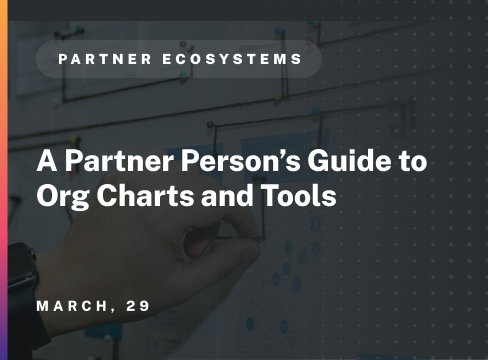Mapping and understanding intricate relationships has become indispensable in a landscape where strategic alliances can make or break a company’s success. With the advent of digital tools and platforms, creating and managing these charts has shifted from a cumbersome manual process to a more streamlined, interactive, and insightful endeavor, offering unprecedented clarity and strategic value to businesses.
The dialogue and insights presented here are drawn from the experiences shared by a diverse group of professionals, each contributing a unique perspective on the challenges and solutions in partnership management.
Contributors include Travis Bradley from Tipalti, Shannon Kluczny from BizLibrary, Danna Nieto from ShipperHQ, Jeannette Arrowood from Pendo, Asher Mathew, Chris Samila and Tai Rattigan from Partnership Leaders, Yeva Roberts from AllCloud, Alexander Shyshko from Outbound Funnel, Craig Bovaird from Procore Technologies, Jakob Stubbe from Adyen, Kelly Sarabyn from HubSpot, Patricia Rush from JSG, and Chris Murray from Influ2.
Their shared experiences and struggles to find the perfect tool for visualizing strategic partnerships offer a foundational perspective on the importance of organizational charts in today’s business landscape.
The Foundation of Strategic Partnerships
Strategic partnerships are intricate business relationships that leverage each other’s strengths to achieve common goals. These alliances vary significantly in structure, purpose, and complexity, ranging from simple co-marketing arrangements to deep, integrated supply chain collaborations. Understanding each partner’s organizational structure is at the core of managing these relationships effectively.
This isn’t just about knowing who reports to whom, though. It’s also about comprehending key information, such as:
- Strategic importance of different departments
- Influence of key individuals
- Internal dynamics that could affect the partnership.
However, creating accurate and insightful organizational charts is challenging, from the ever-changing nature of organizational structures to selecting the right tools for the job. Travis and Shannon have shared that finding innovative and practical solutions to these challenges is vital to maintaining dynamic and productive strategic alliances.
4 Reasons Why You Need to Visualize Organizational Structures
Visualizing organizational structures through org charts is a strategic initiative that drives clarity, enhances communication, and fosters robust partnerships.
Here are four compelling reasons why:
- Clarity and Insight: Organization charts provide a bird’s-eye view of the relational dynamics within and between partnering organizations. This clarity is invaluable for identifying key stakeholders and understanding their roles and influence in the partnership.
- Streamlined Communication: By laying out the organizational structure, org charts facilitate direct and efficient communication. Knowing who to contact and how they fit into the giant puzzle saves time and allows for better communication.
- Strategic Planning: Understanding the hierarchy and structure of partner organizations aids in strategic planning. It enables businesses to identify opportunities for deeper integration, collaboration, and innovation within the partnership.
- Conflict Resolution: Inevitably, conflicts arise in any partnership. A detailed map of organizational structures can help pinpoint the source of issues and guide the resolution process by involving the right people.
3 Challenges in Mapping Complex Partner Ecosystems
Despite the clear benefits, creating accurate and valuable org charts is challenging, mainly when dealing with complex and fluid partner ecosystems.
- Dynamic Changes: Organizations are living entities with frequent role changes, personnel shifts, and restructuring. Keeping org charts up-to-date requires constant vigilance and can be particularly challenging with large, matrix-organized partners.
- Access to Reliable Information: Gathering accurate information about partner organizations’ structure and key personnel can be difficult, especially when partnerships span across different regions and cultures with varying levels of transparency.
- Choosing the Right Tool: As highlighted by the professionals in our conversation, finding a tool that balances ease of use, functionality, and integration with existing systems (like CRM platforms) can be a daunting task. Each organization’s needs are unique, and what works for one may not suit another.
Finding the Perfect Tool
The ideal solution balances ease of use with powerful features integrates smoothly with existing systems, and remains flexible enough to accommodate the dynamic nature of organizational relationships.
Let’s break down the options.
Traditional Partner Mapping Methods
Historically, PowerPoint (PPT) and Excel have been the go-to methods for creating org charts.
These tools are widely available, familiar to most professionals, and sufficient for basic mapping needs. Travis and Shannon highlighted their reliance on these tools for simplicity and accessibility. However, the manual effort required to update these charts and their lack of dynamic integration with real-time data sources are significant drawbacks.
As Jakob mentioned, using Google Sheets and Slides offers a slightly more collaborative approach, allowing teams to share and edit charts in real time. Yet, these methods still need to improve in terms of automation and advanced features that can handle the complexities of modern strategic alliances.
Other Rising Solutions
The conversation among partnership leaders reveals a growing interest in more innovative and specialized tools.
Danna shared her experience working with Miro as a charting tool, while Yeva cited the Squivr app as an excellent companion tool for Salesforce. Both tools offer advanced features that address many of the limitations of traditional methods. These features include:
- Real-time collaboration
- Integration with CRM systems
- Dynamic updating capabilities
Craig introduced another layer of sophistication by utilizing Workday’s function to export org charts. This method streamlines the creation process and enriches the charts with detailed information, including headshots and direct links to profiles, enhancing their overall utility and accessibility for strategic partnership management.
Yeva added that these features are also part of Squivr, along with insights into your champions and detractors in different departments. These insights are crucial for gauging how your relationships affect your partnership.
Lessons Learned and Best Practices
Several key lessons and best practices have emerged through the shared experiences of professionals navigating strategic alliances. These insights are invaluable for any organization enhancing its partnership management strategies.
What Works and What Doesn’t
The diversity in tools and methods discussed by Travis, Shannon, and Yeva underscores that there is no one-size-fits-all solution to creating and managing org charts. However, a common thread among successful strategies is flexibility and adaptability.
Tools that offer real-time collaboration and integration with CRM systems outperform because they accurately reflect the dynamic nature of organizational structures.
Alexander recommends incorporating the Sales Engagement tools to create outbound, inbound, and nurturing tracks. This keeps your “partners and their respective revenue teams engaged,” said Alexander.
Another critical takeaway is the importance of user adoption and ease of use.
Regardless of a tool’s capabilities, its effectiveness is limited by team members’ willingness and ability to use it. Simplifying the transition to new tools through training sessions or choosing intuitive platforms can significantly enhance their impact.
Preparing for the Future
As strategic partnerships evolve, so must the tools and strategies used to manage them.
Staying informed about the latest developments in partnership management technology is crucial. Professionals should be open to experimenting with new tools, like AI solutions mentioned by Chris, which can offer innovative ways to automate and enhance org chart creation and maintenance.
Moreover, fostering a culture of continuous improvement and feedback within the team can lead to more effective use of these tools. Encouraging team members to share their experiences and suggestions can help identify issues early and allow for adopting best practices that benefit everyone involved.
Conclusion
As the landscape of strategic alliances continues to evolve, so will the tools and methods used to manage them. Embracing innovation, flexibility, and a commitment to continuous learning will be essential for any organization looking to thrive in this dynamic environment. Keeping abreast of new technologies and best practices in partnership management will ensure that businesses can maintain and strengthen their strategic alliances, driving mutual success.
Join The 1850+ Leaders Transforming Partnerships
As a member of Partnership Leaders you will:
- Build and learn with the top partner people at the best companies around the world.
- Increase your impact and accelerate your career with proven resources, tools, and best practices.
- Grow a network of peers, partners, and advisors with common objectives.
Drive your strategic clarity and execution by prioritizing your ecommerce team org chart a visualization that transforms partnership management from guesswork into precision. As the article explains, modern tools like Miro, Squivr, and CRM-integrated org chart exports (e.g., from Workday) elevate traditional diagrams into living, real‑time dashboards, empowering teams to identify key stakeholders, map internal influence, and navigate complex alliance structures with ease and accuracy. Ready to take this to the next level? Connect with the partnership leaders company to access expert frameworks, actionable tooling insights, and a thriving network that helps you scale and systematize partnership success.



